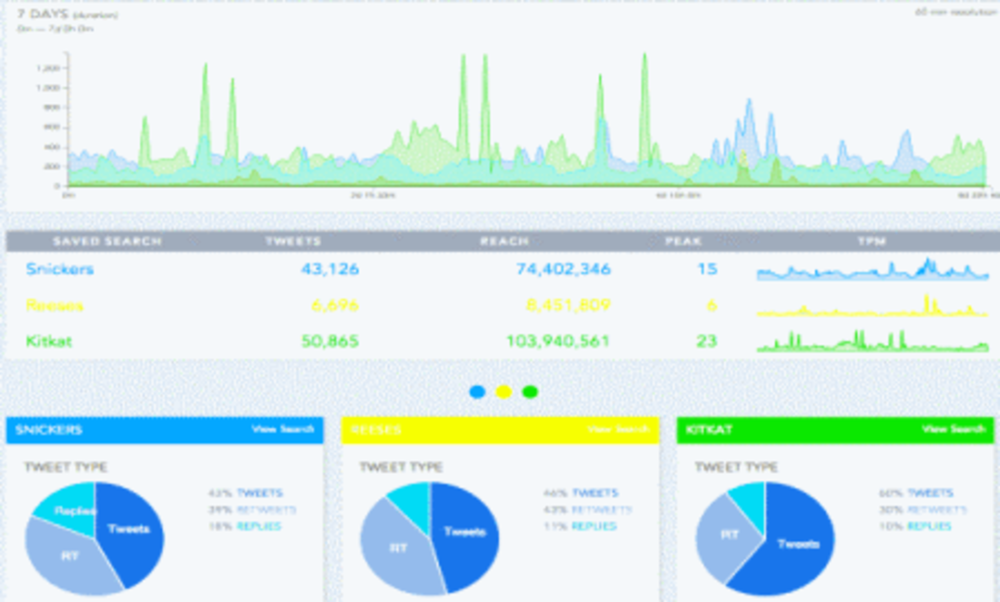Social media marketing platform Spredfast is launching a new tool for Twitter which provides historical data analysis on trending conversations, brand engagement and campaigns.
The new tool, titled “Intelligence,” is closely integrated with Spredfast’s core social media management platform as well as Spark, its real-time marketing tool.
Here are some of the tasks marketers can perform using Intelligence:
– Search for trending terms of topics: Intelligence’s search function is a simple interface that operates similarly to Google’s search box. It allows marketers to search for specific terms or a combination of terms and see the corresponding Twitter activity. For example, if a marketer wanted to search for all Twitter activity surrounding the term “Snickers” the results would show how that topic performed over time ( in terms of tweets per minute,) the major influencers driving the conversation, and a view of the articles, links, pictures and video being circulated. Spredfast’s big selling point is that unlike other business intelligence platforms, it is offering unlimited search.
– Filter search by time period, location, language. This allows users to get even more granular about a search, seeing the activity for a topic only in a specific location or language.
– Compare search terms: For brands that want to conduct business intelligence on their competitors, the platform includes a function which lets users compare the Twitter activity of two different topics or campaigns within the same or different time periods. This enables brands to view their share of voice as compared to a competitor as well as identify trending patterns or opportunities they may have missed. For example, here’s a comparison of all the Twitter activity surrounding Snickers and its competitor candy brands during the same week:
– Create and export reports: All the search activity and analysis can be visualized through charts and graphs created within the platform. These can be exported as standalone reports or pushed to Powerpoint presentations for the marketing team.
Essentially, Intelligence is a tool for making informed decisions on Twitter. The simple search capability is designed to help non-technical marketers make decisions the way the business intelligence or data science team would. At the very least, marketers can use it as a tool to benchmark their social media efforts and support their investment requests.
I spoke with Ran Jaden Cao, social media campaign manager for Playstation, who has been testing the new platform for Spredfast. Cao says he was impressed with the simplicity and effectiveness of the search function, especially when using it to compare the Twitter activity of Playstation competitors. “They’re agile in terms of how easy it is to create topics for analysis,” says Cao. “I would compare the user interface favorably to Topsy, which was another impressive Twitter monitoring platform, (until it got bought by Apple.)”
Cao says he has used Intelligence for identifying locations across the country that are hotspots of Playstation fandom, using that information to chart the route of the Playstation bus tour. He also says he can imagine plenty of crisis management cases for PR where Intelligence would come in handy.
The addition of Intelligence to Spredfast’s suite of social media tools gives it a crucial data analysis component, in addition to its publishing (Conversations), multi-screen engagement (Experiences) and real-time marketing capabilities(Spark).
While Spark is designed to give marketers an instant snapshot of what’s trending in the social media in the world, Intelligence is designed for looking back and evaluating Twitter activity at a given point in time. Spredfast CTO Manish Mehta says Intelligence is geared towards creating a broader based strategy for marketing on Twitter, rather than searching for in-the-moment opportunities provided by Spark.
“We envision these products used by two different types of marketers,” says Mehta. “Marketers who come in and look at daily content to respond to will use Spark, but for users who want to go back and see how a topic has moved over the past 30 or 90 days, they’ll use Intelligence.”







